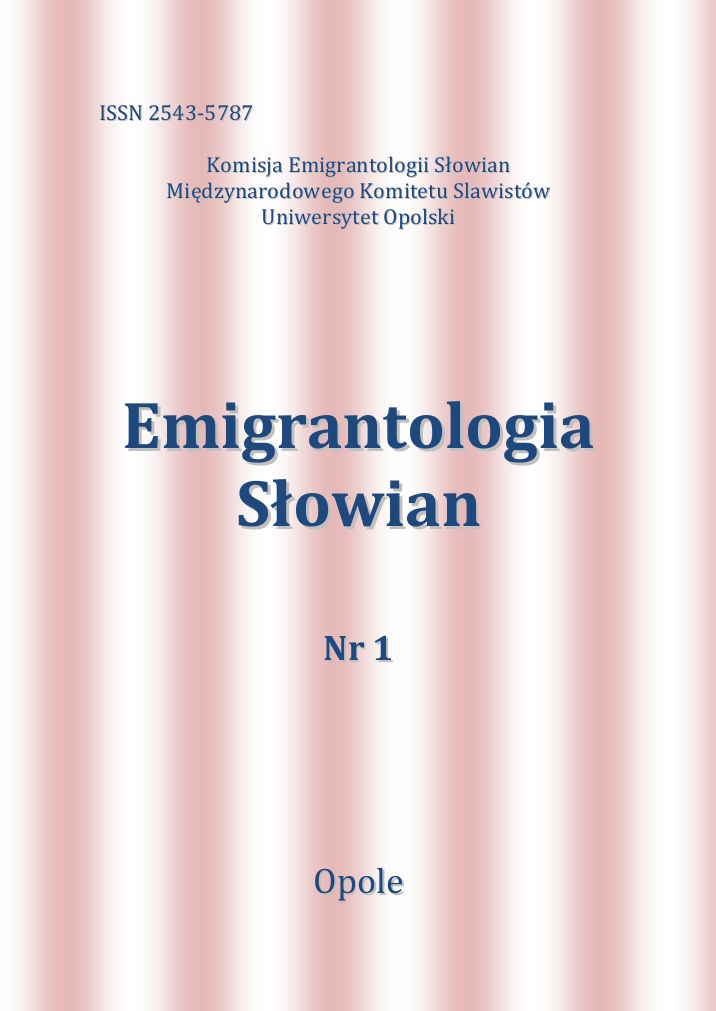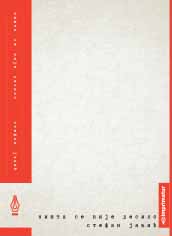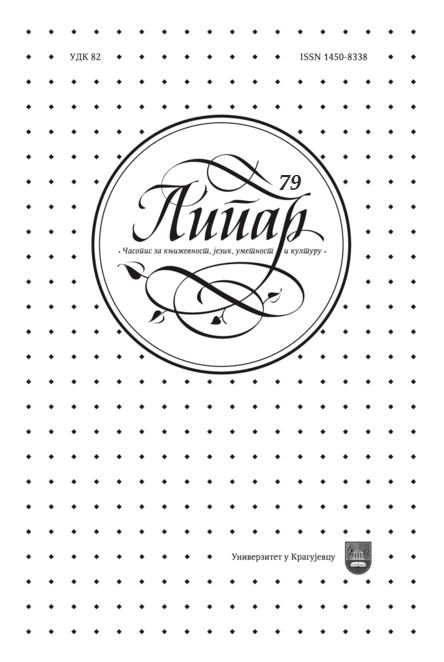
We kindly inform you that, as long as the subject affiliation of our 300.000+ articles is in progress, you might get unsufficient or no results on your third level or second level search. In this case, please broaden your search criteria.


(Čarna je sedela ispod hrasta na Palićkom jezeru s nas nekoliko kad smo odlučile da sastavimo ovu knjigu. Želela je da napiše tekst o lezbejkama u Srbiji i taj bi tekst sigurno bio baršunast i prodoran, kao i poezija koju je pisala. Na žalost svih nas koje smo je poznavale, napustila nas je prebrzo.)
More...
Based on the literary and cultural material, the article discusses two functions played by the term of emigrantology as a legacy of three waves of Russian emigration in the 20th century. The term was introduced by Lucjan Suchanek to the research space of Slavic emigration. It has systematized the area of intellectual and scientific self-reflection (including literary studies, historiography, philosophy and theology, and cultural studies), which developed in the community of Russian emigration. Additionally, the term provides modelling of the need for interdisciplinary and in the nearest future trans-disciplinary studies on the complex cultural phenomenon of Slavic emigrations. In this particular context, the article presents major research directions and achievements of Russian studies in Poland.
More...
Writing about the works of Nenad Ljubinković is no easy task, not just because there are almost four hundred of them and because they encompass almost all the topics of importance that Serbian (and not only Serbian) science of folk literature has dealt with, but first of all because each and every one of them poses a challenge of sorts. His texts, marked by a sharp wit, rich in terms of connotations, re-examine accepted interpretations, coming up with new ones, often contrary to the previously established ones, bringing into question the usual ones. In all of Ljubinković’s studies there is a tendency towards discussing the cultural-historical basis of oral creation, which does not mean that other factors are neglected, such as mythological ones or the mutual connections between the oral and the written at a broader comparative level. What connects all of the above is studying folk literature as a phenomenon.
More...
The paper deals with the so-called ”epic genitive” which in South Slavic epic decasyllable and long-verse poems often substitutes the accusative of inanimate objects, e.g. mača plamenoga ‘(he unsheathed) the fiery sword’ and of direction, e.g. u bijela grada ‘(he went) into the white town’. Such forms are ungrammatical and metrically conditioned, i.e. they fit into the second half-line of the decasyllable, which is not the case with the gramatically correct sentences, e.g. u b(ij)eli grad ‘to the white town’, at least after the loss of the final ”weak” semi-vowels shortly before 1000 A.D., for hitherto, in its original phonetic shape, the sequence *vъ(n) bělъjь gordъ, with six syllables, the penult long and the preceeding two short, perfectly matched the second hemistich of the Common Slavic epic decasyllable as reconstructed by Roman Jakobson; consequently, the pattern must be older than the 10th century and rooted in the prehistoric past. The substitution of genitive for accusative may be regarded as purely morphological process, inspired by the analogy of the category of animate nouns in which genitive is used to design the direct object, and/or by the phonetic coincidence of two Common Slavic prepositions, *vъ ‘in(to)’ with accusative and locative and *u ‘at’ with genitive, in Serbian. However, the starting point of the development may have been a phonetic phenomenon, the persistent pronunciation of final weak semivowels in the metrical speech long after their fall in the spoken language, not unlike the ”e muet” in French poetry, e.g. u Budimə gradə, which subsequently resulted in u Budima grada ‘into the town of Buda’ as the shwa reflecting Common Slavic ъ and ь in the strong position turned, in Shtokavian, into the full vowel a. It was supposedly only then, in the 14th–15th centuries, that the original accusative in those inherited formulas was reinterpreted as a genitive in a. In any case, the ”epic genitive” seems to be an archaism bearing a further testimony to the prehistoric roots of Serbian oral poetry. Additionaly, the occurence in the reconstructed formulas of the word *gordъ ‘town’, initially ‘enclosure, fortified place’, confirms that fortresses played in the epic world outlook of the ancient Slavs a role no less important than among other early Indo-Europeans.
More...
In this paper, the author attempts not only to establish the connections but also to explain the crucial phrase in the poem analysed, lying eyes, relying on his assumption, explained in more detail in the preface to a critical edition of Volume Four of Serbian Folk Poems, that the poem „Old Vujadin” was recorded by Vuk’s well-known blind singer Đuro Milutinović. In the text, the author also comments on the interpretation of that poem and the above-mentioned phrase contained in it by Miodrag Pavlović.
More...
This paper focuses on one of the aspects of the atypical attribution of home in the oral tradition (eternal home = grave). Searching for the origin of the atypical motif of leaving an opening on a coffin wherein the body of a deceased person is placed, encountered in the poem “A Sad Wedding” from the manuscript collection of Jovan Srećković (The Ethnographic Collection of the Serbian Academy of Sciences and Arts, no. 1, 1/55, 48–49а), the authors sift through layers inherited from the ancient Slavic past (confirming the existence of the said motif in the north of Russia and in the regions of the Carpathians, Ukraine, northern Romania and Poland) and follow the connections with lyrical variants (Kosovo) and certain motifs and pat terns (death in the woods, a fairy building a city). Furthermore, the authors point to a transfer of formulas and occasional collisions between the traditional images and layers of epic poetry within the framework of specific poetic creations.
More...
The subject of this paper is the poem “Ivo Senković and Aga of Ribnik” (Serbian Folk Poems III, no. 56), which is connected to the international theme of a duel between an inexperienced hero and a seasoned fighter, and whose content is placed within the framework of the struggle of the uskoks [rebels, guerrilla-type fighters] of Senj against the Turks, while actually being the hero’s very first duel, which can be brought into connection with the quest of a fairy-tale hero. In other words, the unfolding of the plot manifests a morphological equivalence between this heroic poem and a fairy tale, evidencing their common genetic origins, overlapping and layering, even though in the poem there is a great deal of heroic resemantisation of the fairy-tale sujet, which should be evident from a detailed analysis of the poem.
More...
In the context of the bugarštice it is discussed the oral formula of the oldest recorded bugarštica from 15th century. It is studied the complex interweaving flows of the tradition and history in the bugarštice. The metrics and the verse of bugarštice are compared with metric solutions of octosyllabic verse in the oral poetry.
More...


The goal of this paper is to investigate the memory of the Holocaust, i.e. the reception and representation of the suffering of the Jewish population during the rule of the Third Reich (under Nazi rule and occupation) in the capitals of the states constituted after the Second World War - in East Berlin, GDR, and Belgrade, SFRY, during the period from 1945 to 1989/1991. Relying on the achievements of memory studies and analyzing the political moods of that time and the ways of constructing official narratives about Jewish suffering in selected post-war Communist countries, the similarities and differences in the policy of representing Jewish suffering in these two countries and the memory of Jewish victims in places of remembrance and in the practices of remembrance in their capitals will be pointed out.
More...
Serbska ruletka to wybór współczesnych dramatów serbskich. Znalazło się w nim 9 tekstów 9 autorów w następującej kolejności: w tomie pierwszym: Svetislav Basara Dolce vita; Miroljub Nedović Kraina ciemności; Mirjana Ojdanić Ślad ludzkich zębów; Nebojša Romčević Karolina Neuber; w tomie drugim: Goran Marković Willa Sachino; Milena Marković Statek dla lalek; Milena Minja Bogavac Czerwona. Seks i konsekwencje; Marija Karaklajić Twarz ze szkła; Maja Pelević Może jesteśmy Myszką Miki.Wszystkie utwory powstały po 1995 roku i żaden z nich nie był wcześniej ani w Polsce wydany, ani na język polski przetłumaczony. W wyborze uwzględniono zarówno teksty autorów średniego pokolenia, tych o ugruntowanej już pozycji, jak i młodych twórców, czasem zaledwie przed kilkoma laty debiutujących, ale już zauważonych i docenianych, teksty zróżnicowane tematycznie i gatunkowo. Ich autorzy nie są bynajmniej dla polskiego odbiorcy zupełnie anonimowi, trudno bowiem nie rozpoznać chociażby w osobach Gorana Markovicia, Svetislava Basary czy Mileny Marković artystów o międzynarodowej sławie. Wybrane dramaty to sztuki znane w Serbii, ale często też już poza jej granicami, nagradzane, zarówno za tekst, jak i za jego realizację sceniczną, na licznych festiwalach i konkursach teatralnych.
More...
Phenomena defined in contemporary folkloristics as postfolklore, small groups folklore, urban folklore have for long been out of the focus of Serbian folkloristics, and papers on this topic have only recently started appearing. Quite understandably, the studies are directed towards contemporary material. However, the diachronic aspect of these phenomena exists too. The testimonies of the existence of such forms of folklore in the past can be found in memoir and diary literature, as well as in the corpus of historical (not folkloristic) archives. All these past phenomena are covered here with the umbrella term “other folklore” whose function is descriptive, not theoretical. Everything that folkloristic paradigms in the past failed to see as a “real” folklore (equated with oral, rural, and traditional) – making that material invisible and hidden in the sources less used by folklorists – is classified here as “other.” “Other folklore” in this case encompasses a few kinds of folklore: folklore of small groups (criminals and prisoners, students, seminarists) and urban folklore (mostly connected to Belgrade). Political folklore could belong here too. It is often close to traditional genres in its forms, but historical and political conditions have made it unsuitable and evicted it to the out-of-sight memory of memoirs and diaries (such are, say, monarchist songs from World War II, or political jokes from the time of Communism). Political folklore sometimes coincides with other “otherness” categories, say, the parodic urban folklore from the time of the Nazi occupation of Belgrade that is an example both of political and urban creativity; humoristic and unheroic, it did not fit the folklore of resistance ideal even upon the end of the war. Such a corpus approach makes it possible to see the diachronic background of many contemporary examples and discover new sources of folklore in the less examined material. More importantly, the definitions of folklore themselves are tested by this approach (surely, along the lines of Popper’s criticism of “facts,” it is definitely not a “discovery,” but a re-evaluation of concepts before approaching the corpus). Finally, such analyses can be useful to historians too, because they reveal the hidden side of certain epochs and their mind-sets, as well as the genre conditionality of historical sources.
More...
The Ethnographic Collection, today a part of SASA Archives, was initiated by Stojan Novaković in order to continue Vuk Karadžić’s work on collecting folklore. The goal of the Academy was to get the material collected, systematized and published, and the task of collecting was entrusted to individuals, such as teachers and priests, who lived among the people and were literate enough to record various forms of folklore. The questionnaires they used were intended for ethnographic and anthropogeographic research, which means that there were no clear instructions for recording folk tales. In this paper, I use the term textualization (after Lauri Honko), defined here as secondary, because it refers to the representation of the written (rather than spontaneous oral) text, in order to point out different models/strategies of recording folk tales used by collectors in the last decades of the 19th and first decades of the 20th century. Depending on their position, recording of the folklore material was sometimes influenced by ethnography or dialectology, considering that the mentioned disciplines were on their rise, while the literary model appears as a regional distinction.
More...
Book Review: Савремена српска фолклористика VIII ‒ словенски фолклор и књижевна фантастика. Ур. Дејан Ајдачић и Бошко Сувајџић. Београд: Удружење фолклориста Србије, Универзитетска библи- отека „Светозар Марковић”; Кијев: Комисија за фолклористику Међународног комитета слависта; Лозница: Центар за културу „Вук Караџић”, 2020. 518 стр. ISBN 978-86-7301-149-3
More...
Book Review: Ана Вукмановић. У трагању за извир водом. Слике воде у јужнословенској усменој лирици. Београд: Академска књига, 2020. 296 стр. ISBN 978-86-6263-301-9
More...
Book Review: Disenchantment, Re-enchantment and Folklore Genres. Ed. by Nemanja Radulović, Smiljana Đorđević Belić. Belgrade: Institute for Literature and Arts, 2021. 286 pp. ISBN 978-86-7095-286-7
More...
The paper sheds light on the way in which the categories of time and space in demonological-mythological legends constitute a specific chronotope, reflecting the disturbing atmosphere of encounter with the paranormal. The author seeks to expose the poetics of the demonological-mythological legends, with special empha- sis on their temporal and spatial determinants. In the demonological-mythological legends space and time are deeply related. The paper considers the genre determina- tion of the chronotope in demonological-mythological legends and points out that the construction of the narrative world through temporal and spatial categories must proceed in accordance with certain genre laws, so the audience can recognize the story as demonological-mythological legend. This work is based on the folklore material which was gathered from 2018 to 2019 in the Rasina District. Interviews were conducted with two interlocutors from the village of Ribare.
More...
Serbocroatistic contributions have been published on the pages of “Ricerche slavistiche” since 1952, when this academic journal of Slavic Studies was founded by Giovanni Maver at the University of Rome (now Sapienza University). Articles and reviews on various Serbocroatistic topics (that is concerning linguistics, literary history, literary criticism, culture) have been appearing in this journal with such a continuity that they can be included among the most frequent ones.
More...